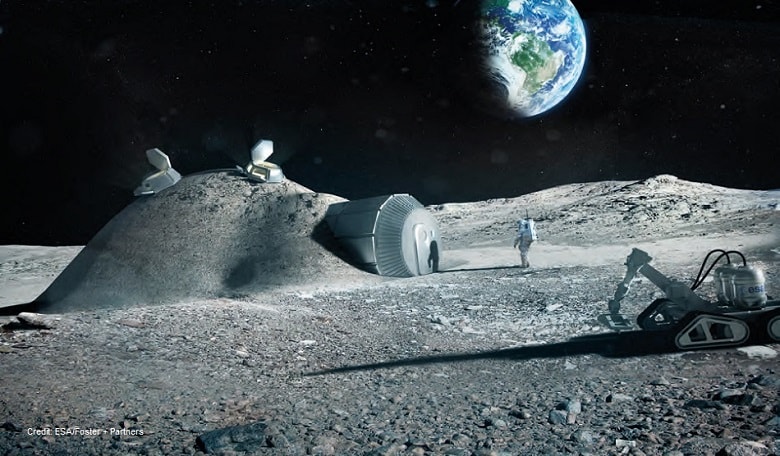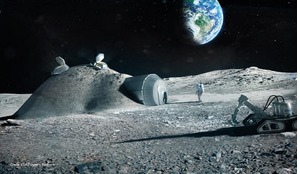Many people wonder how space is linked to sustainability. A common perception is that these two concepts are far apart. On the contrary, a space shuttle or a future lunar base is one of the most durable systems you can imagine; namely a closed ecosystem. Oxygen, water, food and other consumables are scarce and must be allocated carefully and as far as possible be re-used.
These are the lessons that we can learn from space, and apply to sustainability on our own planet. The Swedish Down to Earth mission exists to commercialise space technologies for a sustainable Earth. Sustainability and environmental technologies are cutting edge domains in Sweden that are expected to become even more important for our future industries and a basis for export.
The Down to Earth process is one of creativity designed to bring different disciplines together so that new, sustainability-focused innovations and ideas can be generated. The basic premise is to take advantage of the ideas, methods and materials used in the space industry and render them of practical use to industries and areas of application on the ground. The Down to Earth process begins with workshops from which a wide variety of ideas are hatched, many of which are concrete and implementable for further development.
Umbilical Design sees itself as the creative link in large and often complex development projects.
The objective is to create sustainable products and solutions of commercial viability for Swedish industry and society. The ideas that do not fall within a client’s core business are placed in an ‘outcubator’, where they are developed by teams of students operating in parallel with the company. The method is a sort of “open innovation” and enables crowd-sourcing of radical ideas amongst students.
This approach fosters collaboration between the space, academic and private sectors. Working as part of a collaborative process creates opportunities for taking on the challenges of the future and solving the complex problems to be faced. This inspires students and clients to influence and take an active role in developments.
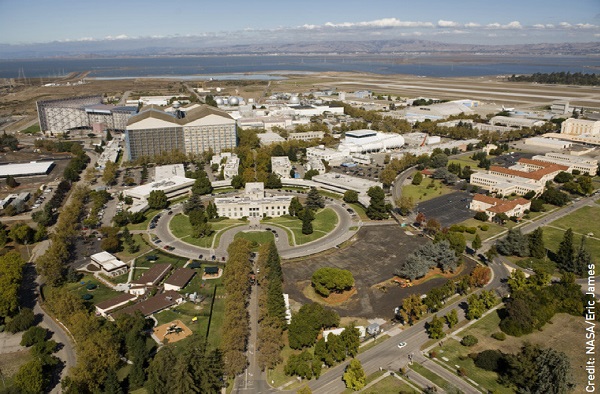 A Swedish delegation visited NASA Ames to meet with experts in fields such as Artificial Intelligence, Robotics, Green Building and Sustainability.
A Swedish delegation visited NASA Ames to meet with experts in fields such as Artificial Intelligence, Robotics, Green Building and Sustainability.
Umbilical
Umbilical Design’s mission is to facilitate the use of space technology and space systems for nonspace applications. It is also to show how design, technology and materials from the space industry can be transferred into sustainable solutions for businesses and society. The focus is on design and architecture for the space industry, extreme environments and global challenges. Umbilical Design operates in three fields: space, extreme environments and household products.
The name was chosen very carefully because not only is umbilical a medical term, it is also used in astronautics to denote a vital link or lifeline between two objects. This is one of the key concepts of the company’s business idea. Umbilical Design sees itself as the creative link in large and often complex development projects.
As a step forward in that direction, a Swedish aerospace delegation visited NASA Ames in San Francisco, June 2013. The group, which included Swedish astronaut Christer Fuglesang, was made up of 14 representatives from Swedish business, academia, and entrepreneurial communities. I led the delegation, and we were invited to meet with experts in various fields such as, Artificial Intelligence, Robotics, Green Building and Sustainability.
Technology developed for space serves as a driving force in developing sustainable solutions for earth. Space technology transfer is a potential growth engine for Sweden and an innovative force for Swedish industry. The Swedish visit to NASA was an important step towards strengthening Sweden’s position in this field.
Thunderwear
One recent example of how Umbilical Design is using its knowledge of space design to develop new products and solutions for earth application with the aim to improve living and working conditions for people in extreme situations or environments is Thunderwear. Umbilical Design initiated the Thunderwear project, which is a joint collaboration with The Swedish Steel Producer association: Jernkontoret and Swedish underwear company Bjorn Borg.
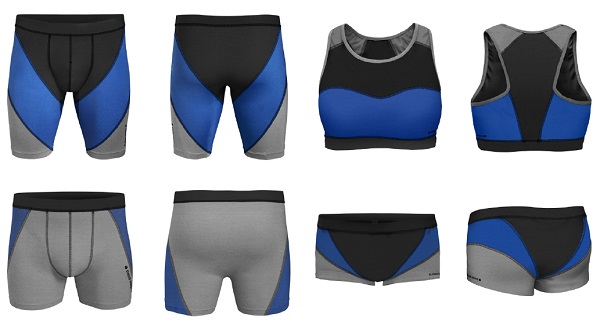 Thunderwear comes from the application of spacesuit technology to underwear.
Thunderwear comes from the application of spacesuit technology to underwear.
The goal of the project is to provide steel workers with flame proof underwear that can handle extreme heat and hard core environments like steel factories. The steel workers normally use cotton underwear while at work, and underneath their protective clothing the heat could ignite the fabric. Umbilical Design contacted their colleagues within the ESA Technology Transfer and sourced a Space fabric used by ESA, NASA and several other Space Agencies in Astronaut Suits.
The UK funding body STFC and Italy’s D’Appolonia both recommended the fabric. It is biodegradeble and used in an astronaut’s suit. Today there is a brand new mini production of Thunderwear that can take up to 350°Celsius (662°Fahrenheit) of scorching heat. Thunderwear was launched in Sweden in July 2014. Participating in the inauguration was, apart from steelworkers and other special invited guests, Swedish ESA astronaut Christer Fuglesang.
With the strong focus on working for sustainability, Umbilical Design was further honoured to be selected as host and co-organizer for the ESA Roundtable in November 2014. Since 2012 ESA Headquarters in Paris, has been organizing these meetings, with the aim that each roundtable debate should relate to one of the pillars of Sustainable Development: environment, social, economics as well as general issues more related to governance. The focus of the two-day meeting Umbilical Design co-organized in 2014 was on Space for Sustainability and Sustainability in the Space sector.
Space technology transfer involves finding technologies and concepts in the space industry that can be applied to other areas, such as in the construction and property industry or for sustainable urban planning.
The aim of the ESA roundtable meeting was to create a platform for these exchanges between actors in the space sector, and to involve other actors with a strong policy and experience in Sustainable Development in the dialogues. In addition, there is the goal to involve local companies and actors in the exchanges with stakeholders and to get insights into local approaches to Sustainable Development.
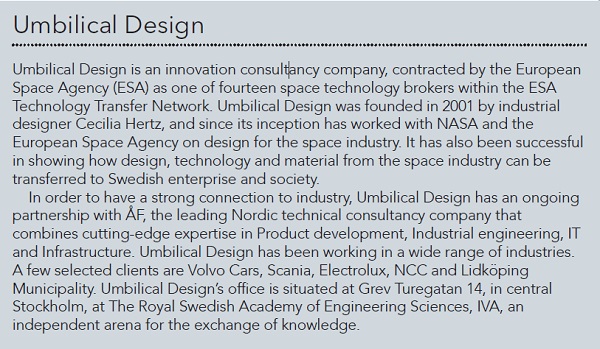
Umbilical Design has recently been chosen by ESA as the lead for the Construction and Furniture sector within the ESA Technology Transfer Network. Aligned with this strategy, the company’s most recent collaboration partner is Swedish property company, Humlegarden Fastigheter. Together the companies will explore how space technology transfer can drive sustainable solutions and innovation in the real estate industry, and see how Sweden can drive sustainable development for the construction industry, using technologies developed for space.
Space technology transfer involves finding technologies and concepts in the space industry that can be applied to other areas, such as in the construction and property industry or for sustainable urban planning.
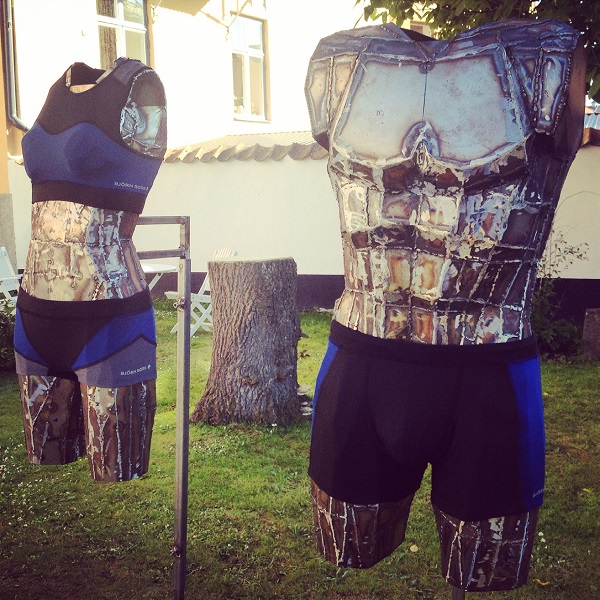 Thunderwear is designed to protect workers in steel factories and other extreme working environments.
Thunderwear is designed to protect workers in steel factories and other extreme working environments.





